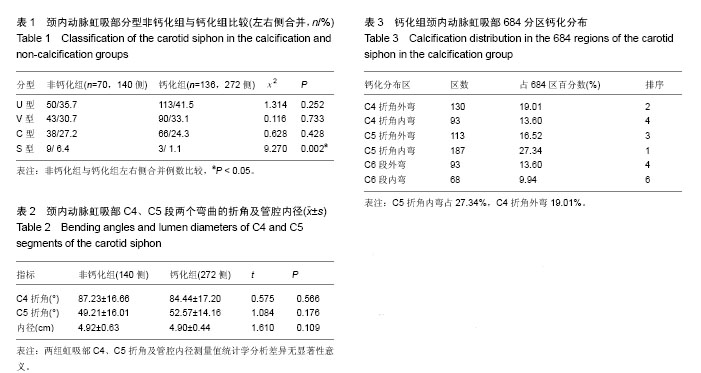中国组织工程研究 ›› 2015, Vol. 19 ›› Issue (15): 2371-2375.doi: 10.3969/j.issn.2095-4344.2015.15.015
• 组织构建基础实验 basic experiments in tissue construction • 上一篇 下一篇
三维重建颈内动脉形态:虹吸部解剖测量与管壁钙化分布
周乐夫1,陈丽君2,段少银2
- 1深圳市龙岗区中医院,广东省深圳市 518172
2厦门大学附属中山医院,福建省厦门市 361004
Three-dimensional reconstruction of the carotid artery: anatomical measurement and calcification distribution of the carotid siphon
Zhou Le-fu1, Chen Li-jun2, Duan Shao-yin2
- 1Shenzhen Longgang Hospital of TCM, Shenzhen 518172, Guangdong Province, China
2Zhongshan Hospital of Xiamen University, Xiamen 361004, Fujian Province, China
摘要:
背景:颈内动脉虹吸部结构复杂,由于颅底骨结构的遮挡,二维影像学观察存在一定的困难。数字减影血管造影(DSA)有利于显示颈内动脉的行程,但缺乏解剖标志。CT三维成像有利于显示颈内动脉管壁、壁内外结构与测量,为相关研究提供了有效的新手段。 目的:明确颈内动脉虹吸部相关形态及钙化分布特点,为相关医学临床与基础研究提供客观依据。 方法:选择50岁以上行头颈CT血管造影检查无明显病变或变异者206例作为研究对象,分为无钙化组70例、钙化组136例。在图像工作站上重建颈内动脉虹吸部,观察其分型(根据虹吸部的解剖形态分为“U”型,“V”型,“C”型,“S” 型)与钙化分布,测量C4、C5弯曲的折角及管腔内径。 结果与结论:颈内动脉虹吸部无钙化组70例,年龄为(59.17±10.27)岁,虹吸部“U”型占35.7%、“V”型30.7%、“C”型占27.2%、“S”型占6.4%,其中两侧分型相同者占33.3%(25/70例);管腔内径为(4.92±0.63) mm,虹吸部C4、C5折角分别为(87.23±16.66)°、(49.21±16.01)°;钙化组136例,年龄为(67.39±9.32)岁,虹吸部“U”型占41.5%、“V”型33.1%、“C”型占24.3%、“S”型占1.1%,其中两侧分型相同者占43.4%(59/136例);管腔内径为(4.90±0.44) mm,虹吸部C4、C5折角分别为(84.44±17.20)°、(52.57±14.16)°。统计学分析两组间年龄、S型分型有显著性差异(P < 0.05),虹吸部管腔内径、C4、C5段折角无显著性差异(P > 0.05)。无钙化组及钙化组C4折角内、外弯区钙化分别占13.60%、19.01%;C5折角占27.34%、16.52%;C6段占9.94%、13.60%。结果表明,颈内虹吸部形态以“U”、“V”、“C”型多见,两侧分型不同超过50%。管壁钙化以C5折角内弯区最多、C4折角外弯区其次,钙化随年龄增大而发生率增多,其中钙化虹吸部S型发生率较低,钙化与管腔、折角大小无明显关系。
中图分类号:

.jpg)